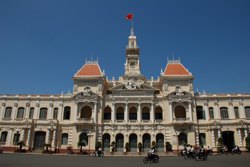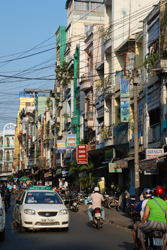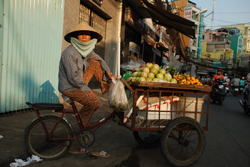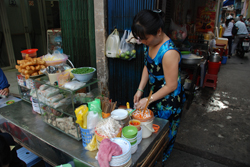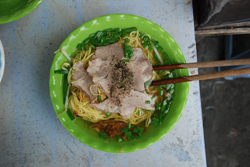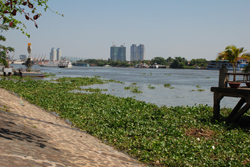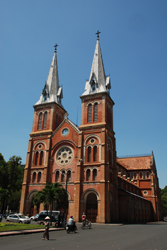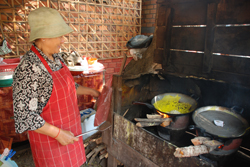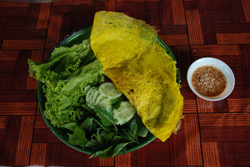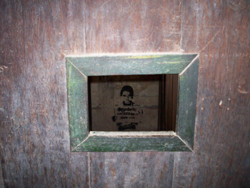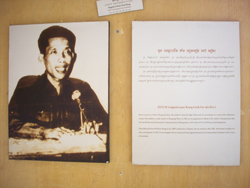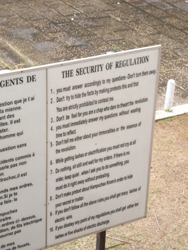Hochi Minh City
19 February, 2009, 02:29 am in "Vietnam"
After Phnom Penh, HCMC is rather pleasant. It is a little less humid and there are sometimes even breezes. The center of town is a mix of French Colonial and more modern buildings. There are parks and tree lined streets. The bus dropped us off right in the center of the tourist area with hotels everywhere. It was a fairly easy country transition compared to some others we've been through. The bus was direct, stopping at the border for a lunch break. The passports were taken care of by the bus company (we had also paid them a few bucks to get our Vietnam visas). It was a pleasant surprise when the bus dropped us off in the center of the tourist area when most other buses go to bus stations farther from the center.
Unfortunately I've had an allergic reaction to the bedbugs at the first hotel we stayed at in Phnom Penh so I have a rash from the back of my knees up my butt to my waist as well as on my upper arms and shoulders. It makes doing everything rather uncomfortable.
Last night after getting settled and eating a dinner of pho and fresh spring rolls from a street cart, we walked through the park where people played a sort of foot badminton-- hacky sack using a big birdie. We had some shakes then went back to the hotel to chill. Today we walked to the Saigon river then around the ritzier tourist area where the Post Office and Notre Dame cathedral are located.
Last night after getting settled and eating a dinner of pho and fresh spring rolls from a street cart, we walked through the park where people played a sort of foot badminton-- hacky sack using a big birdie. We had some shakes then went back to the hotel to chill. Today we walked to the Saigon river then around the ritzier tourist area where the Post Office and Notre Dame cathedral are located.
Seafood Pancakes in Siem Reap
18 February, 2009, 02:29 am in "Cambodia"
While I was sick at the hotel, Rowshan found a great little stand across the river run by a woman and her daughters. He ate lunch and dinner there yesterday and took me there today.
We had Ben Chayi, which are crepes made from rice flour and tumeric, stuffed with pork, beansprouts, little shrimp, and served with lettuce, cucumbers, mint leaves and a sweet dipping sauce with ground peanuts. We also got fried spring rolls. The place is located 1 block N. of Wat Damnak (on the street running behind the wat). To get there from the Old Market, cross the bridge and walk a couple blocks. Look for the stand. They are open 2 -8 PM but closed Sundays. 2000 rs for pancake, 1000 per spring roll.
Phnom Penh: A Visit to the Tuol Sleng Prison Museum
17 February, 2009, 03:54 am in "Cambodia"
Today is the start of the trails of 5 former Khmer Rouge leaders. It has taken 30 years to finally get them to court and several people who held important positions including Pol Pot have died. But at least the trial of some is occurring. The first trial is of “Duch”. He was the head of the infamous S-21 prison here in PP. Coincidentally, R and I chose today to visit Tuol Sleng, “S-21” which is now the Genocide Museum.
Before coming to Cambodia, Rowshan asked me what Cambodia was most famous for. First I answered “Angkor Wat” but then I said, “...no... probably Pol Pot and the Khmer Rouge”. I had definitely heard about Pol Pot and the Khmer Rouge long before I knew anything about Angkor Wat, thanks to the Dead Kennedy's song “Holiday in Cambodia”-- a song that people probably found offensive or shocking at the time. Now I find it interesting that a punk band was singing about the horrible acts of the Khmer Rouge at the time the US was indirectly supporting them and the UN had allowed the Khmer Rouge to represent Cambodia.
The Khmer Rouge were in power from 1975-1979. During this time, in the name of creating a better society, they emptied the cities and forced everyone to work in rural areas in an attempt to increase the output of rice by 400 percent. Instead the results were the deaths of an estimated 2 million people-- a quarter of Cambodia's population through execution or starvation/illness resulting from Khmer Rouge policies. Aside from the forced labor and starvation, Cambodian society was transformed into one governed by fear and distrust. This is a very brief summary of what went on in those years. For a more personal, in depth account, I recommend First They Killed My Father by Luang Ung who was 5 when her family were sent to work in the villages. She describes the starvation, illness, “disappearances” and deaths as well as what was done to survive. Reading it, it was easy to forget the narrator was a 5-7 year old when all of this happened.
We got to the museum in time to catch some of the documentary about it which among other things had the former assistant security person there describe his actions and confirm the torture and mistreatment and executions of prisoners.
The museum/former prison was once a high school. Three 3-story buildings house exhibits on his period in Cambodia's history. We went through backwards starting with some photos and testimonies of people who had been in the Khmer Rouge but also were victims-- stories of what they had to do to stay alive or describing why family members joined the Khmer Rouge to stay alive but were eventually killed by it anyway.
There were photos of the inmates. If I remember correctly, out of 20,000 prisoners, there were only 14 survivors. There were skulls, clothing, instruments of torture and other evidence. The second building contained the cells--some measuring about 2x6 feet. Barbed wire covered the front of the building to keep people from committing suicide by jumping. Other rooms were open and prisoners had been chained together in them. These rooms held an interesting exhibition of photos taken by Gunnar Berstrom who was one of the few foreigners allowed to visit Cambodia during the time the Khmer Rouge was in power. He had been on a tour and the photos contained, “thoughts from 1970” as well as “thoughts today”. It was interesting because at the time, he saw many things positively: a photo of a woman working in the fields said, “This is the solution to feeding the world-- cooperatives with people working together”. Thoughts today “Solidarity comes from the grass roots-- not from threats, force and overwork”. Sometimes he wondered why the government was doing things like letting resources go to waste and why they were so anti-education/intellectuals. He acknowledges how many of the “scenes” he saw had been staged, most likely and that his visit had been used for Khmer Rouge propaganda.
The first building, and the last we visited, was the most stark. This building had been used for torture and interrogation. Most of the rooms just contained a bed and some torture instruments. Some contained a photo of a bloodied torture victim on the bed. Out front was a translation of rules including things like, “While getting lashes or electrification, you must not cry at all.” While we were in the museum, it began to pour down rain as if the world itself were crying for the victims and for the ease with which humanity slips to cruelty.
The Khmer Rouge were in power from 1975-1979. During this time, in the name of creating a better society, they emptied the cities and forced everyone to work in rural areas in an attempt to increase the output of rice by 400 percent. Instead the results were the deaths of an estimated 2 million people-- a quarter of Cambodia's population through execution or starvation/illness resulting from Khmer Rouge policies. Aside from the forced labor and starvation, Cambodian society was transformed into one governed by fear and distrust. This is a very brief summary of what went on in those years. For a more personal, in depth account, I recommend First They Killed My Father by Luang Ung who was 5 when her family were sent to work in the villages. She describes the starvation, illness, “disappearances” and deaths as well as what was done to survive. Reading it, it was easy to forget the narrator was a 5-7 year old when all of this happened.
We got to the museum in time to catch some of the documentary about it which among other things had the former assistant security person there describe his actions and confirm the torture and mistreatment and executions of prisoners.
The museum/former prison was once a high school. Three 3-story buildings house exhibits on his period in Cambodia's history. We went through backwards starting with some photos and testimonies of people who had been in the Khmer Rouge but also were victims-- stories of what they had to do to stay alive or describing why family members joined the Khmer Rouge to stay alive but were eventually killed by it anyway.
There were photos of the inmates. If I remember correctly, out of 20,000 prisoners, there were only 14 survivors. There were skulls, clothing, instruments of torture and other evidence. The second building contained the cells--some measuring about 2x6 feet. Barbed wire covered the front of the building to keep people from committing suicide by jumping. Other rooms were open and prisoners had been chained together in them. These rooms held an interesting exhibition of photos taken by Gunnar Berstrom who was one of the few foreigners allowed to visit Cambodia during the time the Khmer Rouge was in power. He had been on a tour and the photos contained, “thoughts from 1970” as well as “thoughts today”. It was interesting because at the time, he saw many things positively: a photo of a woman working in the fields said, “This is the solution to feeding the world-- cooperatives with people working together”. Thoughts today “Solidarity comes from the grass roots-- not from threats, force and overwork”. Sometimes he wondered why the government was doing things like letting resources go to waste and why they were so anti-education/intellectuals. He acknowledges how many of the “scenes” he saw had been staged, most likely and that his visit had been used for Khmer Rouge propaganda.
The first building, and the last we visited, was the most stark. This building had been used for torture and interrogation. Most of the rooms just contained a bed and some torture instruments. Some contained a photo of a bloodied torture victim on the bed. Out front was a translation of rules including things like, “While getting lashes or electrification, you must not cry at all.” While we were in the museum, it began to pour down rain as if the world itself were crying for the victims and for the ease with which humanity slips to cruelty.
Powered by My Blog 1.69. Copyright 2003-2006 FuzzyMonkey.net.
Created by the scripting wizards at FuzzyMonkey.net..
(Code modified by Rowshan Dowlatabadi)
Created by the scripting wizards at FuzzyMonkey.net..
(Code modified by Rowshan Dowlatabadi)


